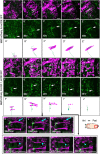Activin is a neural inducer of a male-specific muscle in Drosophila
- PMID: 38355873
- PMCID: PMC10866940
- DOI: 10.1038/s41598-024-54295-3
Activin is a neural inducer of a male-specific muscle in Drosophila
Abstract
Drosophila melanogaster has a pair of male-specific muscles called the muscle of Lawrence (MOL) in abdominal segment 5 (A5) of adult flies. The MOL is produced only when its innervating motoneuron expresses FruitlessM (FruM) neural masculinizing proteins. We show that MOL induction is hampered by: (1) silencing electrical activities in the motoneuron, (2) blocking vesicular release from the motoneuron, and (3) knocking down Activin ß (Actß) in the motoneuron or knocking down Actß signaling pathway components in the myoblasts. Our timelapse live imaging of the developing neuromuscular system reveals that, upon contact with the presumptive MOL, the motoneuronal axon retracts concomitant with the progression of MOL degeneration resulting from neural silencing. We conclude that MOL formation depends on the bidirectional trophic interactions between pre- and postsynaptic cells, with motoneuron-derived Actß playing an inducing role in MOL formation.
© 2024. The Author(s).
Conflict of interest statement
The authors declare no competing interests.
Figures







Similar articles
-
Neuronal synaptic outputs determine the sexual fate of postsynaptic targets.Curr Biol. 2010 May 11;20(9):836-40. doi: 10.1016/j.cub.2010.02.064. Epub 2010 Apr 15. Curr Biol. 2010. PMID: 20399094
-
A fruitless upstream region that defines the species specificity in the male-specific muscle patterning in Drosophila.J Neurogenet. 2015 Mar;29(1):23-9. doi: 10.3109/01677063.2014.983101. Epub 2014 Dec 18. J Neurogenet. 2015. PMID: 25518733
-
Drosophila Activin- and the Activin-like product Dawdle function redundantly to regulate proliferation in the larval brain.Development. 2008 Feb;135(3):513-21. doi: 10.1242/dev.010876. Epub 2008 Jan 2. Development. 2008. PMID: 18171686
-
[Molecular genetics of satori, a Drosophila mutant with altered sexual orientation].Nihon Shinkei Seishin Yakurigaku Zasshi. 2000 Feb;20(1):27-31. Nihon Shinkei Seishin Yakurigaku Zasshi. 2000. PMID: 10890021 Review. Japanese.
-
From action potential to contraction: neural control and excitation-contraction coupling in larval muscles of Drosophila.Comp Biochem Physiol A Mol Integr Physiol. 2009 Oct;154(2):173-83. doi: 10.1016/j.cbpa.2009.04.626. Epub 2009 May 7. Comp Biochem Physiol A Mol Integr Physiol. 2009. PMID: 19427393 Review.
References
-
- Shah NM, Sanes JR. Sexual differentiation of the nervous system (Chapter 51) In: Kandel ER, Koester JD, Mack SH, Siegelbaum SA, editors. Principles of Neural Science. 6. McGraw-Hill; 2021. p. 1646.
MeSH terms
Substances
Grants and funding
LinkOut - more resources
Full Text Sources
Molecular Biology Databases
Research Materials

